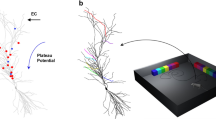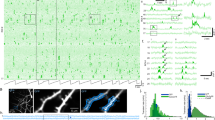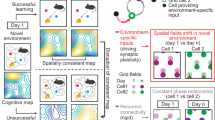Abstract
Place cells develop spatially-tuned receptive fields during the early stages of novel environment exploration. The generative mechanism underlying these spatially-selective responses remains largely elusive, but has been associated with theta rhythmicity. An important factor implicating the transformation of silent cells to place cells is a spatially-uniform depolarization that is mediated by a persistent sodium current. This neuronal current is modulated by extracellular calcium concentration, which, in turn, is actively controlled by astrocytes. However, there is no established relationship between the neuronal depolarization and astrocytic activity. To consider this link, we designed a bioplausible computational model of a neuronal-astrocytic network, where astrocytes induced the transient emergence of place fields in silent cells, and accelerated the plasticity-induced consolidation of place cells. Interestingly, theta oscillations emerged naturally at the network level, resulting from the astrocytic modulation of subcellular neuronal properties. Our results suggest that astrocytes participate in spatial mapping and exploration, and further highlight the computational roles of these cells in the brain.







Similar content being viewed by others
References
Adoff, M. D., Climer, J. R., Davoudi, H., Marvin, J. S., Looger, L. L., & Dombeck, D. A. (2021). The functional organization of excitatory synaptic input to place cells. Nature communications, 12, 1–15.
Amilhon, B., Huh, C. Y., Manseau, F., Ducharme, G., Nichol, H., Adamantidis, A., & Williams, S. (2015). Parvalbumin interneurons of hippocampus tune population activity at theta frequency. Neuron, 86, 1277–1289.
Ashhad, S., & Narayanan, R. (2019). Stores, channels, glue, and trees: active glial and active dendritic physiology. Molecular neurobiology, 56, 2278–2299.
Bi, G.-Q., & Poo, M.-M. (1998). Synaptic modifications in cultured hippocampal neurons: dependence on spike timing, synaptic strength, and postsynaptic cell type. Journal of neuroscience, 18, 10464–10472.
Bittner, K. C., Grienberger, C., Vaidya, S. P., Milstein, A. D., Macklin, J. J., Suh, J., et al. (2015). Conjunctive input processing drives feature selectivity in hippocampal ca1 neurons. Nature neuroscience, 18, 1133.
Bittner, K. C., Milstein, A. D., Grienberger, C., Romani, S., & Magee, J. C. (2017). Behavioral time scale synaptic plasticity underlies ca1 place fields. Science, 357, 1033–1036.
Brocard, F., Shevtsova, N. A., Bouhadfane, M., Tazerart, S., Heinemann, U., Rybak, I. A., & Vinay, L. (2013). Activity-dependent changes in extracellular ca2+ and k+ reveal pacemakers in the spinal locomotor-related network. Neuron, 77, 1047–1054.
Brown, R. A., Walling, S. G., Milway, J. S., & Harley, C. W. (2005). Locus ceruleus activation suppresses feedforward interneurons and reduces \(\beta\)-\(\gamma\) electroencephalogram frequencies while it enhances \(\theta\) frequencies in rat dentate gyrus. Journal of Neuroscience, 25, 1985–1991.
Burgess, N., Maguire, E. A., & O’Keefe, J. (2002). The human hippocampus and spatial and episodic memory. Neuron, 35, 625–641.
Buzsáki, G. (2002). Theta oscillations in the hippocampus. Neuron, 33, 325–340.
Buzsáki, G., Buhl, D. L., Harris, K. D., Csicsvari, J., Czéh, B., & Morozov, A. (2003). Hippocampal network patterns of activity in the mouse. Neuroscience, 116, 201–211.
Buzsáki, G., Vanderwolf, C. H., et al. (1983). Cellular bases of hippocampal eeg in the behaving rat. Brain Research Reviews, 6, 139–171.
Colgin, L. L., Moser, E. I., & Moser, M.-B. (2008). Understanding memory through hippocampal remapping. Trends in neurosciences, 31, 469–477.
Condamine, S., Lavoie, R., Verdier, D., & Kolta, A. (2018). Functional rhythmogenic domains defined by astrocytic networks in the trigeminal main sensory nucleus. Glia, 66, 311–326.
Cressant, A., Muller, R. U., & Poucet, B. (2002). Remapping of place cell firing patterns after maze rotations. Experimental brain research, 143, 470–479.
Curreli, S., Bonato, J., Romanzi, S., Panzeri, S., & Fellin, T. (2022). Complementary encoding of spatial information in hippocampal astrocytes. PLoS biology, 20, e3001530.
De Pittà, M., Brunel, N., & Volterra, A. (2016). Astrocytes: orchestrating synaptic plasticity? Neuroscience, 323, 43–61.
Deemyad, T., Lüthi, J., & Spruston, N. (2018). Astrocytes integrate and drive action potential firing in inhibitory subnetworks. Nature communications, 9, 1–13.
Dong, C., Madar, A. D., & Sheffield, M. E. (2021). Distinct place cell dynamics in ca1 and ca3 encode experience in new environments. Nature communications, 12, 1–13.
Doron, A., Rubin, A., Benmelech-Chovav, A., Benaim, N., Carmi, T., Kreisel, T., Ziv, Y., & Goshen, I. (2021). Hippocampal astrocytes encode reward location. bioRxiv, .
Epsztein, J., Brecht, M., & Lee, A. K. (2011). Intracellular determinants of hippocampal ca1 place and silent cell activity in a novel environment. Neuron, 70, 109–120.
Espinoza, C., Guzman, S. J., Zhang, X., & Jonas, P. (2018). Parvalbumin+ interneurons obey unique connectivity rules and establish a powerful lateral-inhibition microcircuit in dentate gyrus. Nature communications, 9, 1–10.
Frank, L. M., Stanley, G. B., & Brown, E. N. (2004). Hippocampal plasticity across multiple days of exposure to novel environments. Journal of Neuroscience, 24, 7681–7689.
Fujita, Y., & Sato, T. (1964). Intracellular records from hippocampal pyramidal cells in rabbit during theta rhythm activity. Journal of Neurophysiology, 27, 1011–1025.
Gerlai, R., Wojtowicz, J. M., Marks, A., & Roder, J. (1995). Overexpression of a calcium-binding protein, s100 beta, in astrocytes alters synaptic plasticity and impairs spatial learning in transgenic mice. Learning & Memory, 2, 26–39.
Golomb, D., Yue, C., & Yaari, Y. (2006). Contribution of persistent na+ current and m-type k+ current to somatic bursting in ca1 pyramidal cells: combined experimental and modeling study. Journal of neurophysiology, 96, 1912–1926.
Grienberger, C., Milstein, A. D., Bittner, K. C., Romani, S., & Magee, J. C. (2017). Inhibitory suppression of heterogeneously tuned excitation enhances spatial coding in ca1 place cells. Nature neuroscience, 20, 417–426.
Haas, J. S., Nowotny, T., & Abarbanel, H. D. (2006). Spike-timing-dependent plasticity of inhibitory synapses in the entorhinal cortex. Journal of neurophysiology, 96, 3305–3313.
Halassa, M. M., Fellin, T., Takano, H., Dong, J.-H., & Haydon, P. G. (2007). Synaptic islands defined by the territory of a single astrocyte. Journal of Neuroscience, 27, 6473–6477.
Hassanpoor, H., Fallah, A., & Raza, M. (2014). Mechanisms of hippocampal astrocytes mediation of spatial memory and theta rhythm by gliotransmitters and growth factors. Cell biology international, 38, 1355–1366.
Hasselmo, M. E. (2005). What is the function of hippocampal theta rhythm?–linking behavioral data to phasic properties of field potential and unit recording data. Hippocampus, 15, 936–949.
Hasselmo, M. E., Alexander, A. S., Dannenberg, H., & Newman, E. L. (2020). Overview of computational models of hippocampus and related structures: Introduction to the special issue.
Hasselmo, M. E., Wyble, B. P., & Wallenstein, G. V. (1996). Encoding and retrieval of episodic memories: role of cholinergic and gabaergic modulation in the hippocampus. Hippocampus, 6, 693–708.
Haydon, P. G., & Nedergaard, M. (2015). How do astrocytes participate in neural plasticity? Cold Spring Harbor perspectives in biology, 7, a020438.
Heinemann, U., Lux, H., & Gutnick, M. (1977). Extracellular free calcium and potassium during paroxysmal activity in the cerebral cortex of the cat. Experimental Brain Research, 27, 237–243.
Hsu, C.-L., Zhao, X., Milstein, A. D., & Spruston, N. (2018). Persistent sodium current mediates the steep voltage dependence of spatial coding in hippocampal pyramidal neurons. Neuron, 99, 147–162.
Ivanov, V. A., & Michmizos, K. P. (2021). Increasing liquid state machine performance with edge-of-chaos dynamics organized by astrocyte-modulated plasticity. In 35th Conference on Neural Information Processing Systems (NeurIPS 2021) (pp. 1–10).
Jeewajee, A., Lever, C., Burton, S., O’keefe, J., & Burgess, N. (2008). Environmental novelty is signaled by reduction of the hippocampal theta frequency. Hippocampus, 18, 340–348.
Kastanenka, K. V., Moreno-Bote, R., De Pittà, M., Perea, G., Eraso-Pichot, A., Masgrau, R., et al. (2020). A roadmap to integrate astrocytes into systems neuroscience. Glia, 68, 5–26.
Lee, D., Lin, B.-J., & Lee, A. K. (2012). Hippocampal place fields emerge upon single-cell manipulation of excitability during behavior. Science, 337, 849–853.
Lisman, J. E. (1997). Bursts as a unit of neural information: making unreliable synapses reliable. Trends in neurosciences, 20, 38–43.
Milstein, A. D., Li, Y., Bittner, K. C., Grienberger, C., Soltesz, I., Magee, J. C., & Romani, S. (2020). Bidirectional synaptic plasticity rapidly modifies hippocampal representations independent of correlated activity. BioRxiv.
Monaco, J. D., Rao, G., Roth, E. D., & Knierim, J. J. (2014). Attentive scanning behavior drives one-trial potentiation of hippocampal place fields. Nature neuroscience, 17, 725–731.
Morquette, P., Verdier, D., Kadala, A., Féthière, J., Philippe, A. G., Robitaille, R., & Kolta, A. (2015). An astrocyte-dependent mechanism for neuronal rhythmogenesis. Nature neuroscience, 18, 844.
Nardin, P., Tortorelli, L., Quincozes-Santos, A., De Almeida, L. M. V., Leite, M. C., Thomazi, A. P., et al. (2009). S100b secretion in acute brain slices: modulation by extracellular levels of ca 2+ and k+. Neurochemical research, 34, 1603–1611.
Nishiyama, H., Knöpfel, T., Endo, S., & Itohara, S. (2002). Glial protein s100b modulates long-term neuronal synaptic plasticity. Proceedings of the National Academy of Sciences, 99, 4037–4042.
Nitz, D., & McNaughton, B. (2004). Differential modulation of ca1 and dentate gyrus interneurons during exploration of novel environments. Journal of neurophysiology, 91, 863–872.
O’Keefe, J. (1976). Place units in the hippocampus of the freely moving rat. Experimental neurology, 51, 78–109.
O’keefe, J., & Nadel, L. (1978). The hippocampus as a cognitive map. Oxford: Clarendon Press.
Pedrosa, V., & Clopath, C. (2020). The interplay between somatic and dendritic inhibition promotes the emergence and stabilization of place fields. PLoS computational biology, 16, e1007955.
Perea, G., Navarrete, M., & Araque, A. (2009). Tripartite synapses: astrocytes process and control synaptic information. Trends in neurosciences, 32, 421–431.
Pike, F. G., Meredith, R. M., Olding, A. W., & Paulsen, O. (1999). Postsynaptic bursting is essential for ‘hebbian’induction of associative long-term potentiation at excitatory synapses in rat hippocampus. The Journal of physiology, 518, 571–576.
Polykretis, I., Ivanov, V., & Michmizos, K. P. (2018). A neural-astrocytic network architecture: Astrocytic calcium waves modulate synchronous neuronal activity. In Proceedings of the International Conference on Neuromorphic Systems (pp. 1–8).
Pouille, F., Marin-Burgin, A., Adesnik, H., Atallah, B. V., & Scanziani, M. (2009). Input normalization by global feedforward inhibition expands cortical dynamic range. Nature neuroscience, 12, 1577–1585.
Pouille, F., & Scanziani, M. (2001). Enforcement of temporal fidelity in pyramidal cells by somatic feed-forward inhibition. Science, 293, 1159–1163.
Ryczko, D., Hanini-Daoud, M., Condamine, S., Bréant, B. J., Fougère, M., Araya, R., & Kolta, A. (2021). S100\(\beta\)-mediated astroglial control of firing and input processing in layer 5 pyramidal neurons of the mouse visual cortex. The Journal of physiology, 599, 677–707.
Sakatani, S., Seto-Ohshima, A., Shinohara, Y., Yamamoto, Y., Yamamoto, H., Itohara, S., & Hirase, H. (2008). Neural-activity-dependent release of s100b from astrocytes enhances kainate-induced gamma oscillations in vivo. Journal of Neuroscience, 28, 10928–10936.
Salinas, E., & Thier, P. (2000). Gain modulation: a major computational principle of the central nervous system. Neuron, 27, 15–21.
Sheffield, M. E., Adoff, M. D., & Dombeck, D. A. (2017). Increased prevalence of calcium transients across the dendritic arbor during place field formation. Neuron, 96, 490–504.
Sheffield, M. E., & Dombeck, D. A. (2019). Dendritic mechanisms of hippocampal place field formation. Current opinion in neurobiology, 54, 1–11.
Sibille, J., Duc, K. D., Holcman, D., & Rouach, N. (2015). The neuroglial potassium cycle during neurotransmission: role of kir4. 1 channels. PLoS computational biology, 11.
Sjöström, J., & Gerstner, W. (2010). Spike-timing dependent plasticity. Spike-timing dependent plasticity, 35.
Stroud, J. P., Porter, M. A., Hennequin, G., & Vogels, T. P. (2018). Motor primitives in space and time via targeted gain modulation in cortical networks. Nature neuroscience, 21, 1774–1783.
Su, H., Alroy, G., Kirson, E. D., & Yaari, Y. (2001). Extracellular calcium modulates persistent sodium current-dependent burst-firing in hippocampal pyramidal neurons. Journal of Neuroscience, 21, 4173–4182.
Swinehart, C. D., & Abbott, L. (2005). Supervised learning through neuronal response modulation. Neural computation, 17, 609–631.
Takahashi, H., & Magee, J. C. (2009). Pathway interactions and synaptic plasticity in the dendritic tuft regions of ca1 pyramidal neurons. Neuron, 62, 102–111.
Tchernichovski, O., Benjamini, Y., & Golani, I. (1998). The dynamics of long-term exploration in the rat. Biological cybernetics, 78, 423–432.
Thompson, S. M., Berkowitz, L. E., & Clark, B. J. (2018). Behavioral and neural subsystems of rodent exploration. Learning and motivation, 61, 3–15.
Turi, G. F., Li, W.-K., Chavlis, S., Pandi, I., O’Hare, J., Priestley, J. B., Grosmark, A. D., Liao, Z., Ladow, M., Zhang, J. F., et al. (2019). Vasoactive intestinal polypeptide-expressing interneurons in the hippocampus support goal-oriented spatial learning. Neuron, 101, 1150–1165.
Vanderwolf, C. H. (1969). Hippocampal electrical activity and voluntary movement in the rat. Electroencephalography and clinical neurophysiology, 26, 407–418.
Wilson, M. A., & McNaughton, B. L. (1993). Dynamics of the hippocampal ensemble code for space. Science, 261, 1055–1058.
Wulff, P., Ponomarenko, A. A., Bartos, M., Korotkova, T. M., Fuchs, E. C., Bähner, F., et al. (2009). Hippocampal theta rhythm and its coupling with gamma oscillations require fast inhibition onto parvalbumin-positive interneurons. Proceedings of the National Academy of Sciences, 106, 3561–3566.
Yue, C., Remy, S., Su, H., Beck, H., & Yaari, Y. (2005). Proximal persistent na+ channels drive spike afterdepolarizations and associated bursting in adult ca1 pyramidal cells. Journal of Neuroscience, 25, 9704–9720.
Acknowledgements
This research was supported by the National Center for Medical Rehabilitation Research (NIH/NICHD) K12HD093427 Grant and the Rutgers Office of Research and Innovation. I.P. was partially funded by the Onassis Foundation Scholarship.
Author information
Authors and Affiliations
Corresponding author
Ethics declarations
Competing interest
The authors declare that they have no competing financial interests.
Conflict of interest
The authors declare no conflict of interest.
Additional information
Action Editor: T. Sejnowski
Publisher’s Note
Springer Nature remains neutral with regard to jurisdictional claims in published maps and institutional affiliations.
Supplementary Information
Below is the link to the electronic supplementary material.
Rights and permissions
About this article
Cite this article
Polykretis, I., Michmizos, K.P. The role of astrocytes in place cell formation: A computational modeling study. J Comput Neurosci 50, 505–518 (2022). https://doi.org/10.1007/s10827-022-00828-6
Received:
Revised:
Accepted:
Published:
Issue Date:
DOI: https://doi.org/10.1007/s10827-022-00828-6




